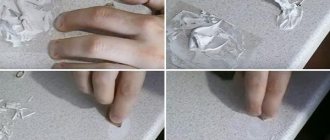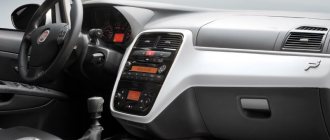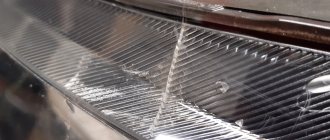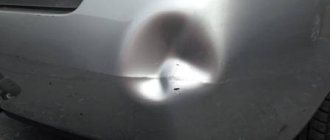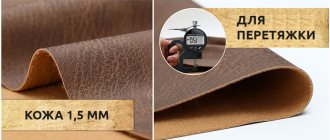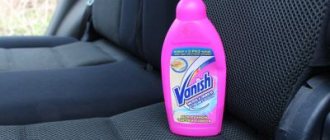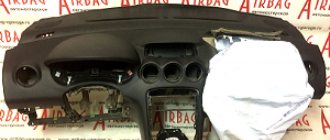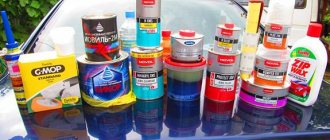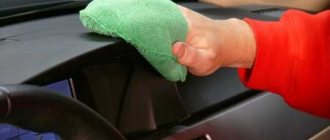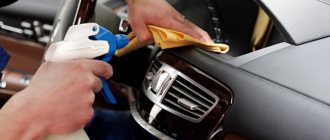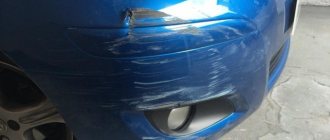Car interior plastic restorer - a review of traditional methods
Good afternoon dear friends.
It's no secret that over time, plastic parts of a car's interior lose their original appearance - they fade, become covered with scratches and stains. Every owner wants his “iron horse” to always look like new. For this, there is a special interior plastic restorer that costs a lot of money, and the effect will not always be long-lasting. There are ways to restore the plastic of a car interior from scratches and return it to its original condition without resorting to store-bought products. Today in the article we will look at several similar folk methods. They are simple and inexpensive, relative to specialized tools. Compare for yourself, and if you are lazy, they will do it for you - watch the video at the end of the material.
Plastic recovery methods
There are several ways to improve the appearance of plastic parts, thereby extending the life of the car interior. The most effective of them include a plastic restorer, the use of a polish, a plasticizer gel or a special film. You can also restore the appearance of plastic by heating it with a hair dryer. Now in more detail about each of the methods.
How to restore interior plastic
Plastic restorer
Used to restore surfaces such as vinyl and plastic. The principle of operation of the restorer is to completely fill existing scratches. The substance penetrates deep into uneven areas and displaces the dirt accumulated there. Immediately after the restorer has dried, you need to clean the surface using special wipes. If necessary, the procedure can be repeated.
Doctor Wax - plastic restorer
Application of polish
Polish is great for covering up minor scratches. It is also used as a final step after using other means. Depending on the color of the plastic, you need to purchase a certain type of polish. Such products contain coloring pigments that additionally mask damage.
Polish for car interior plastic
Heating with a hairdryer
Heating with a hairdryer is excellent for restoring the interior dashboard. The essence of this method is the prolonged exposure of high temperature to the damaged surface, as a result of which the plastic melts slightly and, as a result, becomes level. The required temperature can only be achieved using an industrial hair dryer.
Hairdryer for scratches on plastic
Note! It is not recommended to use a hair dryer on painted surfaces. Also, this method will not be effective in removing large scratches.
Gel plasticizer
After application, the gel imitates the texture of the surface, thereby restoring the damaged area. The gel plasticizer is used as follows:
- the product is applied to an undamaged plastic surface;
- a texture pattern appears on the gel after complete hardening;
- the resulting helium cast is applied to the area to be restored;
- the impression is pressed tightly against the plastic;
- a texture pattern is “imprinted” on the surface.
Gel plasticizer
Gel plasticizer gives the desired result only when restoring a small area of damage. If the plastic is worn out enough, then you need to choose another method.
Restoration of car interior elements
Tire ink
Yes, yes, you heard right. It can be used to restore plastic parts of car interiors. In order not to waste too much money, we will take homemade tire ink; its recipes are described in previous articles. The composition for blackening rubber is similar to the composition of store-bought reducing agents. It also contains glycerin, distilled water, and alcohol.
I would like to immediately warn particularly suspicious car owners. The tire blackening solution and the interior plastic restorer use the same components. Therefore, you will not harm the interior elements.
If you don’t believe me with enough experience using this method, then experiment with plastic parts of the exterior or engine compartment. If nothing happens to them, then feel free to use it in the salon.
Preparation and use
- We wash the plastic elements of the car interior. You don’t have to do this, but the effect after pre-washing will be better. All dirt and dust will be washed off from them
- We take tire ink, store-bought or homemade - it doesn’t matter. Apply it to the surface with a sponge and rub. Store-bought analogues contain products with enhanced shine or antistatic effects - if you need this, use store-bought
- Let it dry, then use a sponge again, preferably a clean one, to polish the finished surface.
Reanimation of damaged plastic
Step 1. Remove the plastic interior elements that need to be restored. The removed parts will be much easier to process.
Removing plastic interior elements
Step 2: Thoroughly wipe the plastic surface with a dry cloth to remove any layer of accumulated dirt.
Cleaning the plastic surface from dirt
Step 3. This is what the cleaned surface should look like. Now you can begin the restoration.
The part is cleaned and ready for restoration
Step 4: Prepare a can of black spray paint. You will also need a plastic primer.
Preparation of materials for restoration
Step 5. Wear rubber gloves before starting the process, as working with paint without protection is not recommended.
Putting on protective gloves
Step 6. Degrease the surface of the part before applying paint. This is necessary to ensure reliable fixation of paints and varnishes.
Surface degreasing
Step 7. Repeat the degreasing procedure with all dismantled elements.
Degreasing of all dismantled elements
Step 8. After the surface has dried, apply a layer of primer, shaking the can thoroughly before doing this. The product must be applied in accordance with the manufacturer's recommendations (you will find all the necessary information on the can).
Applying a layer of primer
Important! The primer's job is to create adhesion between the surface of the plastic part and the paint layer.
Step 9. Prime other elements as well. After this, the parts should dry well.
Drying the primer layer
Step 10: Shake the spray paint can and paint the first element. To make the paint adhere better, it is advisable to warm up the can (approximately to eating temperature).
Spray painting parts
Step 11. When applying a layer of paint, the can must be held at right angles to the surface to be painted.
Applying paint at right angles
Step 12. Wait for the paint to dry. In sunny weather, the part can be placed outside to speed up the drying process.
Drying the paint layer
Step 13. This is what the plastic element looks like after painting.
The part is painted and looks like new
Step 14. Paint the remaining parts in the same way.
Painting the remaining dismantled elements
Step 15. Interior parts are painted and ready for installation. Now they can breathe new life into the car interior.
Interior plastic restored and ready for installation
Silicone
To restore the plastic of the car interior from scratches, we will use a special product from the store. Let's read its composition. It turns out that it uses regular silicone. So why overpay?
We take regular silicone grease for car door seals and apply it to the scratch. We fill it with silicone, partially masking it. Its cost is lower than purchased car interior plastic polishes - around 35 rubles. In this way, you can “disguise” small scuffs from shoes on door panels or thresholds.
Important! It is worth understanding that silicone grease will not completely remove deep scratches, but it will partially eliminate them.
Then we apply tire ink and give the parts a radical black color - cheap and looks cool.
Plastic restoration products
You can restore the interior plastic using degraders. These are special products for restoring plastic elements. Below are the most effective blackeners from different manufacturers.
Plastic restoration products
Table. Review of plastic restoration products.
| Product name, photo | Description |
| DoctorWax | An excellent ink designed to restore not only plastic interior elements, but also the car body. DoctorWax can be applied to paintwork. |
| Sonax | German restorer for rubber and plastic surfaces from a German manufacturer. Sonax also has a glossy effect. |
| Runway | Polish in the form of milk from the famous American manufacturer NOWAX. The product is very easy to use. It is enough to spray it on the surface to be restored and treat it with microfiber. |
| Meguiar's | Another representative of the American market. Meguiar's can be used for restoration of plastic and rubber. The product is also effective in restoring vinyl. |
| QuickWax | Black polymer for plastic restoration. In addition to the blackening effect, QuickWax is also able to protect the surface from moisture. |
On a note! The average cost of a reducing agent in a 500 ml container is 600-750 rubles. But if you buy 330 ml, the price will be lower - within 300 rubles.
Foam from a car wash
This product is ideal for washing dirty stains on light-colored plastic interior elements. If there is a self-service car wash in your city, then you can put the finished foam in a liter jar - this will be enough. If not, then we buy it at the nearest car wash, it costs a penny, or we make it ourselves.
Why liter? Because if you take a smaller container, then after the foam “settles”, there will be little money left in the jar. A liter is enough to renew the plastic in the car interior.
How to use
- We need to wet the surface that we will wash so that the dirt on it will acidify.
- We take the remaining foam that remains in the jar, wash the plastic with it
- Rinse with water
Types of Damage
We remove chips and scratches on paintwork.
Small scratches are often found inside the car, intertwining into a web of damage. As a result, the appearance of the interior is spoiled, which requires the search for camouflage techniques. Knowing your options, you can remove defects in a short time with minimal financial costs.
More serious costs will be incurred if you have to repair deep damage, since many defects cannot be hidden using simple techniques. The following are the most common methods that will help remove unwanted scratches, thereby improving the appearance of your car's interior.
There are several options for scratching plastic in the car interior:
- Small cracks in the car formed when the material comes into contact with the driver’s keys and other personal belongings that come into contact with the panel.
- Deep large cracks that require a more detailed approach to their destruction.
- Scratches caused by the sun as a result of its action. The fact is that after radiation the surface becomes dull and loses its color.
The removal process is not always simple; major repairs of the products will be required.
Restoration of car interior plastic. DIY + video
It's no secret that after a certain mileage, the plastic of the car interior (and the engine compartment) fades, becomes dull, faded, and in general, loses its original charm. Is it possible to somehow restore it, and do it all with your own hands? Or is this not real at all? It turns out you can do it in budget ways, which I’ll tell you about today. As usual there will be a text version + video at the end...
To be honest, modern plastic does not fade so quickly (the chemical industry works well). It simply gets clogged with dirt and loses its original blackness.
If the interior of your car is light or gray, then you notice black stains (or stains) that just... don’t want to go away! What to do? Clean, and on a budget. I have only three points that really work and have helped me more than once.
Foam from the sink
Of course, you can buy various interior cleaning products from an auto cosmetics store. However, the cost is sometimes not at all budgetary, about 300 - 400 rubles per “bottle”. BUT why overpay?
For many years now, on several cars, I have been using regular foam, the kind that is used in car washes (including self-service ones). Works great
You just need to take a jar, I take one with a large neck (and a screw-on lid), go to the car wash and ask the washer to fill the jar. Usually they always pour it for free. In the case of a self-service car wash , you must pour the foam yourself. It will cost really little, usually about 1 - 2 rubles.
After some time, the foam will settle, you will have about a third of a can of special detergent left.
Using my example, I decided to clean the plastic (restore its color) under the hood and then the door “cards” (in simple terms, the upholstery).
We start with the decorative engine cover:
- Let's get her wet first
- Then we take the foam (or rather, the product that has settled) and clean the dirt with a rag
- Wash off with water (more details in the video below)
The “lid” becomes almost black, very similar to new. Now you can tell me - “why can’t you just walk with water?” It's simple, water won't be able to completely clean the dirt, so it won't be possible to restore it to its original blackness; after drying, there will be gray stains again. Therefore, the use of shampoo is mandatory.
By the way, I decided to wash part of the plastic in the engine compartment and compare it with the part that was not washed at all.
As you can see, it turns out to be very effective, and most importantly, very budget-friendly.
Cleaning leather seats using available products
Washing powder
Cleaning leather car seats is significantly more difficult than cleaning a regular sofa due to the logistical difficulty of getting to the dirt. However, below we have described ways to clean leather seats using available products.
To clean with improvised means, prepare the “ground” for cleaning the seats with a vacuum cleaner, as in the previous point - this is a mandatory element to suck up dust and crumbs - use a nozzle with soft upholstery so as not to damage the skin. Be sure to remove any clumps of dirt that often collect between the backrest and the cushion. Fill a spray bottle with warm water and add a teaspoon of scented detergent—these products together will leave your upholstery fresh and smelling new.
Household products
For a more natural approach to cleaning car seats, try a vinegar-water solution:
- First, fill a spray bottle three-quarters full with vinegar, then add warm water.
- Spray the resulting solution from a distance of about 20 cm
- Lightly rub the solution into the seat with a damp chamois
- Fill the bottle with water, rinse the seat and let it dry for great results.
Tip Once you have clean leather car seats, you will want to keep them that way forever. Apply conditioning and moisturizing cleaning every three months or so to protect the material from heat, sunlight and run-through spills.
Silicone
I talked about the door cards, I also washed them with foam. BUT there is one problem, at the bottom of the doors there are scuffs from shoes. They can be removed in various ways, including polishes - plastic restorers.
We take this polish and read how it restores scratches. It just applies silicone, fills the cracks, and they are partially masked.
So I have concentrated silicone, which I bought at a regular radio parts store (for 35 rubles). We take it and apply it to our “scuffs” and some of them actually hide. BUT it is not possible to remove the deep ones, this must be understood.
Tire ink
Sometimes, summer or winter, I blacken the tires of my car, they look better this way (personally, I like the option with glitter). Moreover, the composition often does not contain any ingredients that could somehow negatively affect the rubber.
Often the “ink” consists of: Glycerin, alcohols, distilled water, liquefied gas and various surfactants
BUT wait! Can it be used on plastic? YES OF COURSE YOU CAN! After all, car plastic polish (both with and without a restoration effect) often contains almost identical components.
So you can safely process it. The black velvet color is restored - “WELL”! Moreover, there are inks that have an antistatic effect (it will be written so on the bottle), which means that dust will not settle much.
After processing, the engine compartment simply sparkled black, just like on a new car. YES, the plastic door trim has also been noticeably updated.
This way you can process everything in the car, both the front panel and the central one. First we clean and wash, then silicone, then black.
Now we are watching the video version of the article.
As you can see, very useful tips, especially now in the spring, when many people are selling cars and want them to look 100%.
Moreover, the price if you break down the costs: 2 rubles foam (taking into account that you pour it yourself at a self-service car wash) + silicone 35 rubles + ink (the cheapest can be found for 60 rubles) = 97 rubles. As you can see, it's very affordable.
I’ll end here, there will be a lot more useful materials. Sincerely yours, AUTOBLOGGER
(
3 votes, average: 5.00 out of 5)
Restoring plastic with polish
Step 1. Prepare cleaner and polish. In this case, products from are used, but if you wish, you can take another brand.
Preparing cleaner and polish
Step 2. Dilute the concentrate with water in a ratio of 1:10.
Diluting the concentrate with water
Step 3. Pour the finished product into a plastic bottle and install the sprayer.
Installing a sprayer on a bottle
Step 4. Apply a layer of cleaner to the surface to be restored.
Applying a layer of cleaner
Step 5. Wait 20-30 seconds for the product to be absorbed into the interior material.
The product must be absorbed
Step 6. Wipe the plastic thoroughly with a regular dishwashing sponge.
Processing plastic with a sponge
Step 7. Using a wet cloth, carefully remove any remaining product from the surface.
Removing product residues
Step 8: Dry the plastic surface using a clean rag.
Wiping the plastic surface with a rag
Step 9. This is what the plastic looks like after cleaning.
Plastic after the cleaning stage
Step 10. Apply a thin layer of matte polish to the cleaned surface. The right side is polished, while the left side is only cleaned (for comparison).
Applying matte polish
Step 11. Rub the polish with a sponge to distribute the polish evenly. Then wait 5 minutes for the product to be absorbed.
Distribution of polish over the surface
Step 12. Clean the surface with a dry cloth. You need to rub in until the matte effect is completely achieved.
Wiping the surface with a dry cloth
Step 13: Done! The plastic has been restored and is ready for use. It is recommended to repeat this procedure every 2-3 months, and then the salon will always look like new.
The interior plastic panel has been restored
Types and causes of damage to plastic
Scratches on the plastic of a torpedo are a common occurrence. They can be caused by various objects, or even the opening and closing of doors. This is due to the fact that plastic surfaces do not have an anti-shock coating, and the slightest mechanical impact leads to a flaw. Minor defects and deep scratches on the instrument panel spoil the appearance of the car’s interior as a whole. However, such damage can be corrected without dismantling the plastic elements.
Direct sunlight causes the paint on the interior parts of the car to fade. To restore such a part, it will be necessary to carry out a major overhaul of the element.
Plastic restorer Doctor Wax
Doctor Wax cleaners and restorers for plastic car parts are no less effective. The composition of the restorers is a unique formula of polymer-active components that bind damaged plastic fibers, restore the structure and give rich color to the products.
Result after use:
- Deep cleaning and restoration in one procedure.
- Removes static electricity and gives the surface water- and dirt-repellent properties.
- Does not leave fatty traces.
- Prevents degradation (destruction) of polymer products.
The method of application is simple: just apply the product to a cleaned plastic panel and rub thoroughly with a soft cloth. After the matte shade appears, remove excess product and leave the surface to dry for 3-4 minutes.
How to remove scratches on plastic inside a car
To remove scratches from plastic in a car, use several methods:
- Small defects can be eliminated using thermal treatment. To do this, use a hairdryer or lighter.
- Small damages are removed with special restorative napkins and towels.
- Deep defects are painted over with automotive wax pencils.
- Scratches are removed from glossy surfaces with polishes and abrasive gels.
- Cracks, chips and deep damage to the paintwork of the torpedo can be eliminated by overhauling the part.
Repair of corrugated surfaces is not possible. They cannot be polished or heat treated. When such elements wear out, they are replaced with new ones.
Restorative pencils and napkins
One of the simplest methods for restoring the appearance of a damaged part is to use special napkins, microfiber towels and a pencil to remove scratches from plastic. However, the use of these means to eliminate defects has a number of nuances:
- Napkins and towels make it possible to get rid of minor scratches on the plastic surface of a car dealership.
- Deep chips and scratches can be erased with a special pencil. These devices are sold in car dealerships. The advantage of this product is its effectiveness. The substance fills defects and gives the surface its original appearance. However, keep in mind that only an original pencil can cope with the problem. Its cost is high, and cheap Chinese analogues will be of little help if the car's dashboard is scratched.
- When painting, select the pencil color that is closest to the shade of the dashboard. Otherwise, after restoration, black marks remain on the surface, spoiling the appearance of the part.
Wax pencils for removing scratches from plastic in the interior
The painted material will not be restored with gel if the scratch is deep; wax pencils of different colors are used. First, the coating is degreased, the abrasion is removed, and the wax quickly fills the gap.
Types of damage:
- Small ones appear most often and are easily and cheaply removed.
- Deep ones are more difficult to repair; there is no need to replace parts.
- Deformation caused by ultraviolet radiation is more difficult to correct; you have to take the car to a workshop.
Often several flaws of varying depths appear in one area, and major repairs have to be carried out.
Car owners try to improve their appearance on their own, but they do not always manage to do it correctly. You have to pay a lot of money at the service station so as not to damage the car even more. There are hundreds of poker rooms on the Internet, which differ in the choice of entertainment, the level of players and limits. PokerDom is one of the best services in demand among clients. With it, anyone can become a poker professional without the risk of losing money.
Instructions:
- The scratched cover is removed.
- Dirt is removed.
- The problem area is primed.
- The part is sanded, painted, and dried before processing.
- The coating is varnished.
- Polishing gives the product shine.
Some flaws are difficult to repair; all the linings have to be repainted the same color.
Car enthusiasts' opinion:
- There is no point in repainting or changing the door card due to minor defects.
- A construction hairdryer can damage fusible material.
- Sandpaper leaves new abrasions.
- You cannot cover them with stickers.
- Not all workshops carry out such restoration.
Features of hand polishing:
- Suitable for small items and small areas.
- You will need a homogeneous paste without impurities.
- The oil gives a glossy shine.
- The abrasive is applied with felt or felt in a circular motion without pressure.
- Treatment lasts 15-20 minutes.
https://youtube.com/watch?v=G19J6sA6h84
X
Overhaul of plastic
It is not always possible to repair the plastic in the car interior using simple methods. Chips, cracks, areas of faded paint - all this requires a major overhaul of the plastic elements of the car dashboard. Restoration is performed in the following way:
- The damaged part is dismantled.
- Thoroughly cleaned of dirt, degreased and polished.
- Cracks and chips are covered with a primer.
- The surface is polished.
- Apply paint and allow the element to dry.
- Cover with several layers of varnish.
- Polish until a glossy shine appears.
How to properly remove scratches from gloss
Transparent plastic is used in the design of many interior elements. The disadvantage of this material is the rapid appearance of defects: small scratches and chips, after several years of operation of the car, literally cover the entire surface of the interior element. Removing scratches from car interior plastic has a number of nuances:
- Before carrying out restoration, you need to wet clean the car interior. It is necessary to ensure that there is no dust. Otherwise, new scratches may appear on the surface during polishing.
- The area to be treated will need to be thoroughly washed and degreased.
- To get rid of scratches, use a sanding machine.
- To polish the damaged area, it is recommended to use products that are designed for polishing plastic. These are special polishes and abrasive pastes. It is important to correctly calculate the amount of substance applied.
Abrasive pastes, gels and polishes, which are intended for polishing the car body, cannot be used when restoring the interior. They will ruin the part being restored.
Numerous defects, scratches, chips and cracks spoil the appearance of the car dashboard. Damage of this kind can be easily repaired on your own. To ensure that the repair process is effective and does not lead to replacement of the part, take into account the nuances of restoring the plastic elements of the interior.
